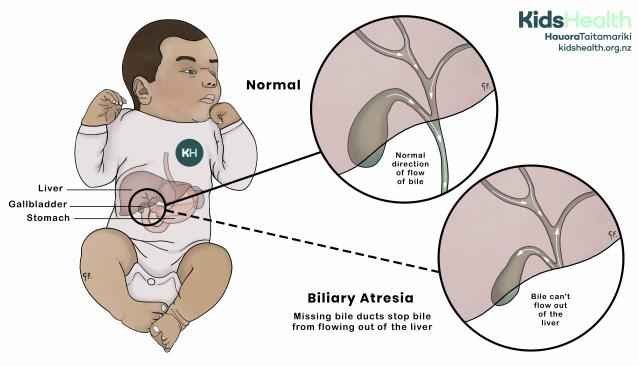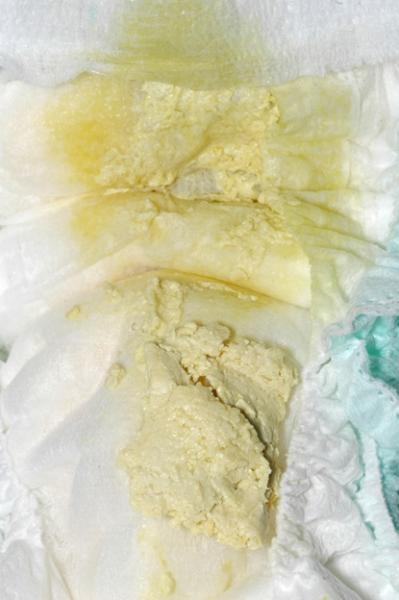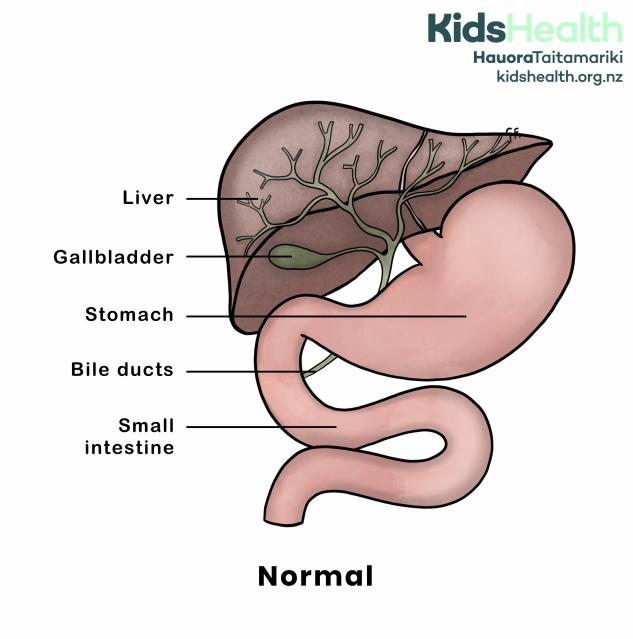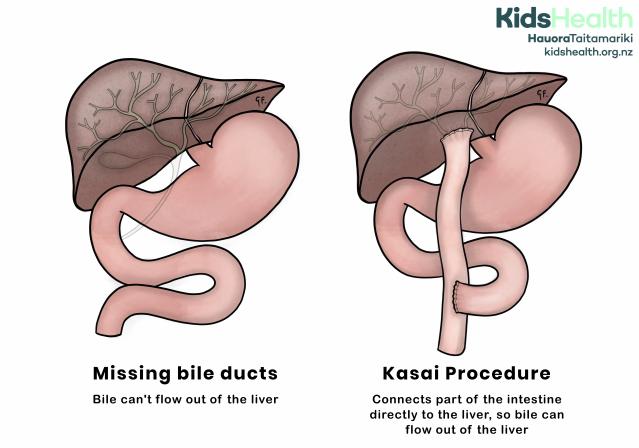Key points about biliary atresia
- biliary atresia is a rare but serious liver disorder that affects newborn pēpi
- biliary atresia causes jaundice that continues after 2 weeks of age in newborn pēpi
- pēpi need special tests to diagnose biliary atresia
- treatment involves surgery as early as possible to minimise liver damage
- the surgery is not always successful
- if the liver is badly damaged, a liver transplant may be necessary

An illustration showing how biliary atresia blocks the normal flow of bile from the liver.
Source: KidsHealth
transcribeTranscript
The illustration shows a baby sitting upright. The organs are visible, including the liver, gallbladder, and stomach, each labelled.
Two close-up circles show the bile ducts inside the liver:
- The top circle, labelled Normal, shows the normal direction of flow of bile moving from the liver through the ducts into the gallbladder and intestine.
- The lower circle, labelled Biliary Atresia, shows bile can’t flow out of the liver because the bile ducts are missing or blocked.
At the top right is the KidsHealth logo with the website: kidshealth.org.nz.
What is biliary atresia?
Biliary atresia is a condition that happens when irritation and swelling (inflammation) develop in the bile ducts of infants. The inflammation can happen in any of the bile ducts inside and outside the liver. This causes bile duct damage.
When the ducts are damaged, the bile cannot flow out of the liver. Bile is trapped and causes scarring of the liver. This scarring is called fibrosis. The bile ducts outside the liver are always permanently damaged preventing any bile flow into the gut. The gall bladder is also affected.
Causes of biliary atresia
The cause of biliary atresia is not known. There is currently no known way of preventing biliary atresia, or of predicting when it will occur.
Early signs of biliary atresia
In the first few weeks of life, pēpi with biliary atresia often seem well apart from having yellow skin and whites of the eyes. This yellow colour is called jaundice. Most pēpi with jaundice are healthy and the jaundice fades over the next few weeks. In biliary atresia, the jaundice does not fade or it gets worse over time.
The following are important signs to look out for.
Dark wee
A baby's wee should not have any colour.
Pale poo
White, cream, grey or beige-coloured poo. Baby poo is normally green or yellow.
Bleeding
Bleeding that lasts longer than normal. Common places pēpi can bleed from are the nose or mouth.
When to get medical help for your baby with jaundice
You should see a health professional or lead maternity carer (LMC) if your baby:
- is still jaundiced at 2 weeks of age
- becomes jaundiced after 2 weeks of age
- has pale, white or light beige-coloured poo
- has yellow or dark wee

Photo of a nappy with pale poo and dark wee.
Source: KidsHealth
Photo supplied by Dr Helen Evans (consultant paediatric hepatologist and gastroenterologist, Starship).
Diagnosing biliary atresia
There are many reasons why your baby might be jaundiced after the age of 2 weeks. A health professional, midwife or LMC should check your baby. A health professional, midwife or LMC should ask for a blood test to help find the reason for the jaundice. Biliary atresia is very rare, so the blood test may show another cause for the jaundice.
If the health professional suspects biliary atresia, they will make an urgent appointment for your baby with a paediatrician (a specialist in children's health).
Your baby may have:
- more blood tests
- an ultrasound scan of the liver
- a liver biopsy
Treating biliary atresia
The treatment for biliary atresia is a surgery called the Kasai procedure. The surgery involves connecting part of the intestine directly to the liver so that bile is able to flow from the liver to the intestine.

An illustration showing a liver with normal bile ducts connecting the liver, gallbladder, and small intestine.
Source: KidsHealth
transcribeTranscript
The liver is shown above the stomach and small intestine. Labels identify the:
- liver
- gallbladder
- stomach
- bile ducts
- small intestine
The bile ducts connect from the liver and gallbladder to the small intestine.
The KidsHealth logo with the website kidshealth.org.nz appears in the top right corner.

An illustration showing the missing bile ducts in biliary atresia (left) and the Kasai procedure which is used to treat biliary atesia (right).
Source: KidsHealth
transcribeTranscript
On the left, the illustration labelled Missing bile ducts shows that bile can’t flow out of the liver because the bile ducts are absent.
On the right, the illustration labelled Kasai Procedure shows a surgical connection between the intestine and liver, allowing bile to flow directly out of the liver.
The KidsHealth logo with the website kidshealth.org.nz appears in the top right corner.
This operation works best if your baby is young (less than 2 months old). The operation does not always cure biliary atresia, even when it is done early.
If the operation does not help, then over time your child's liver will become more and more damaged. This leads to liver failure. The only cure for liver failure is a liver transplant.
Possible complications of biliary atresia
Biliary atresia can cause a number of problems.
Growth problems
Your baby will not be able to digest the fats from breastmilk or normal formula milk because bile (needed for fat digestion) is not getting into the intestine. This leads to poor growth. Your baby may need a special feed that contains a different kind of fat, that they can digest better. Some pēpi need extra feeds or supplements through a feeding tube to help them grow.
Vitamin deficiencies
Vitamins A, D, E and K dissolve in fat so they cannot be absorbed properly into the body in biliary atresia. Your baby will need extra medicine to provide these vitamins.
Itching
Liver disease may cause a baby to be very itchy. This problem does not affect all pēpi with jaundice, but it can be quite distressing. Your baby may need medicine to help with the itch.
Other problems
If the Kasai surgery is unsuccessful and the liver starts to fail, other problems may occur. Your specialist team will talk to you about the risks for your baby and the things to watch out for.
More information

Visit the Cincinnati Children's website for more detailed information on biliary atresia.
Acknowledgements
Illustrations by Dr Greta File. Property of KidsHealth.
